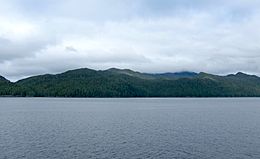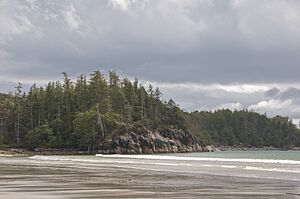Calvert Island (British Columbia) facts for kids

Calvert Island from Fitz Hugh Sound
|
|
| Lua error in Module:Location_map at line 420: attempt to index field 'wikibase' (a nil value). | |
| Geography | |
|---|---|
| Location | Queen Charlotte Sound |
| Archipelago | North Coast Archipelago |
| Area | 334.27 km2 (129.06 sq mi) |
| Length | 32 km (19.9 mi) |
| Width | 16 km (9.9 mi) |
| Highest elevation | 1,045 m (3,428 ft) |
| Highest point | Mount Buxton |
| Administration | |
| Province | British Columbia |
| Regional district | Central Coast |
Calvert Island is a beautiful island located off the coast of British Columbia, a province in Canada. It sits to the east of Queen Charlotte Sound. This island is part of the Central Coast region. It's about 100 kilometers (62 miles) north of Port Hardy. Port Hardy is a town found at the northern tip of Vancouver Island.
Contents
What's in a Name?
Calvert Island got its name in 1788. It was named by Captain Charles Duncan. He was the captain of a fur trading ship called the Princess Royal. The name likely honors the Calvert family. It might specifically be for Lord Cecil Calvert, who was the second Baron of Baltimore. Later, George Vancouver kept the name on his maps, making it official.
Exploring Calvert Island's Geography
Calvert Island is quite long, stretching about 32 kilometers (20 miles). Its width changes, from 3 kilometers (1.9 miles) to 16 kilometers (9.9 miles). The island covers an area of 334.27 square kilometers (129.06 square miles). The highest point on the island reaches 1045 meters (3,428 feet) above sea level.
Just north of Calvert Island are several smaller islands. The largest of these is Hecate Island. These islands are separated from Calvert Island by Kwakshua Channel. To the north, Hakai Passage separates the islands around Calvert Island from those near Hunter Island. On the east side, Fitz Hugh Sound acts as a natural border. This sound is part of the famous Inside Passage. It separates Calvert Island from the mainland. The entrance to Rivers Inlet is also east of the southern part of Calvert Island.
A Glimpse into History
Calvert Island is part of the traditional lands of the Heiltsuk people. Their territory stretched north along Dean Channel and Burke Channel. It also included coastal islands up to Milbanke Sound.
Archaeological findings show that people have lived in this area for thousands of years. In 2015, scientists from the Hakai Institute and the University of Victoria made an exciting discovery. They found human footprints on the island. These footprints could be as old as 13,200 years! This makes them the oldest known human footprints in North America. Scientists believe the footprints belong to a man, a woman, and a child. This discovery supports an idea called the "Kelp Highway" hypothesis. This idea suggests that ancient kelp forests along the North Pacific coast helped people travel and settle in the Americas.
In July 1788, a British fur trader named Charles Duncan arrived in the Calvert Island area. He anchored his ship, the Princess Royal, in Milbanke Sound. Then, he traveled south, trading with the Heiltsuk people. He explored waters that were unknown to the British at that time. He sailed through Hakai Passage into Fitz Hugh Sound. He then anchored on the east coast of Calvert Island in a place called Safety Cove. After a short stay, he continued his journey south towards Vancouver Island.
Protected Natural Areas
North of Calvert Island, in Hakai Pass, is the Hakai Luxvbalis Conservancy Area. This area is huge, covering over 1200 square kilometers (300,000 acres) of land and sea. It is the largest provincial marine protected area along the British Columbia Coast. This means it's a special place where nature is kept safe.
Another important protected area is the Hakai Provincial Recreation Area. It covers 50,707 hectares (125,299 acres). This area includes the northern part of Calvert Island. It also covers the southern part of Hunter Island. Many other smaller islands in the region are part of this protected area too.


